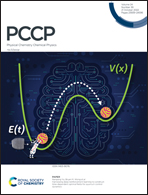Prediction of highly stable two-dimensional materials of boron and phosphorus: structural and electronic properties†
Abstract
The discovery of two-dimensional (2D) semiconducting materials has attracted broad research interest, owing to their wide applications in spintronics and optoelectronics. Group III–V 2D materials such as hexagonal boron nitride (h-BN) have been demonstrated with remarkable electronic properties. However, the 2D materials consisting of boron and phosphorus have not been comprehensively explored. Using global structural search combined with first-principles calculations, we have hereby theoretically predicted several stable and metastable boron phosphorus (BmPn) monolayer 2D compounds that have lower formation enthalpies (ΔH) than black phosphorus and α-bulk boron and could be formed at stoichiometries of m/n ≤ 1. Two of these 2D BmPn compounds, i.e., P21/m B1P3 and Cm B2P4, are confirmed to be thermodynamically stable, with bandgaps less than 2 eV. In particular, Cm B2P4 features a narrow bandgap of ∼0.609 eV, near the short wavelength infrared ray (SWIR) region, and it possesses anisotropic mechanical properties. Moreover, we have demonstrated that these compounds can be converted into half-metallic spin-polarized states through charge doping, which promises their applications in spintronic devices.



 Please wait while we load your content...
Please wait while we load your content...